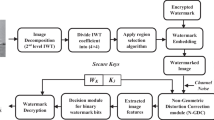Abstract
With the widespread internet usage, digital contents are easily distributed throughout the world. To eliminate concerns of producers and owners of digital contents, watermarking techniques are extensively being used. Robustness against intentional and unintentional attacks is a major quality of watermarking systems. Since different attacks tend to target different parts of the frequency spectrum, in this paper we propose a framework for blind watermarking which determines the type of attack that the image has gone through before extracting the watermark. Within this framework, we propose an attack classification method to identify the region of the frequency spectrum that is less damaged. The watermark which is redundantly spread throughout the spectrum can be extracted from the less damaged regions. Experimental results show functionality of the framework by producing better results in comparison with well-known blind watermarking techniques.







Similar content being viewed by others
References
Akhaee MA, Sahraeian S, Sankur B, Marvasti F (2009) Robust scaling-based image watermarking using maximum-likelihood decoder with optimum strength factor. IEEE Transactions on Multimedia 11(5):822–833
Akhaee MA, Sahraeian SME, Craig J (2011) Blind image watermarking using a sample projection approach. IEEE Transactions on Information Forensics and Security 6(3):883–893
Al-Haj A (2007) Combined DWT-DCT digital image watermarking. J Comput Sci 3(9):740–746
Azzari L, Foi A (2014) Indirect estimation of signal-dependent noise with non-adaptive heterogeneous samples. IEEE Trans Image Process 23(8):3459–3467
Burgett S, Koch E, Zhao J (1994) A novel method for copyright labeling digitized image data. Technical Report of Fraunhofer Institute for Computer Graphics, Darmstadt
Chen YH, Huang HC (2015) Coevolutionary genetic watermarking for owner identification. Neural Comput & Applic 26(2):291–298
Chu SC, Huang HC, Shi Y, Wu SY, Shieh CS (2008) Genetic watermarking for zerotree-based applications. Circuits, Systems & Signal Processing 27(2):171–182
Corel Draw Software and Dataset available at: http://www.corel.com
Craver S, Memon N et al (1998) Resolving rightful ownerships with invisible watermarking techniques: limitations, attacks, and implications. IEEE Journal on Selected Areas in Communications 16(4):573–586
Fan Y, Zhu YS, Liu Z (2016) An improved SIFT-based copy-move forgery detection method using T-linkage and multi-scale analysis. Journal of Information Hiding and Multimedia Signal Processing 7(2):399–408
Fazlali HR, Samavi S, Karimi N, Shirani S (2016) Adaptive blind image watermarking using edge pixel concentration. Multimedia Tools and Applications 1:16
Hamghalam M, Mirzakuchaki S, Akhaee MA (2014) Geometric modelling of the wavelet coefficients for image watermarking using optimum detector. IET Image Process 8(3):162–172
Jiang J, Feng G (2002) The spatial relationship of DCT coefficients between a block and its sub-blocks. IEEE Trans Signal Process 50(5):1160–1169
Kang X, Huang J, Zeng W (2008) Improving robustness of quantization-based image watermarking via adaptive receiver. IEEE Transactions on Multimedia 10(6):953–959
Li Z, Yap KH, Lei BY (2011) A new blind robust image watermarking scheme in SVD-DCT composite domain. Proc. of IEEE International Conference on Image Processing (ICIP) 2757–2760
Miller ML, Cox IJ, Linnartz JP, Kalker T (1999) A review of watermarking principles and practices. Digital Signal Processing for Multimedia Systems:461–485
Nasir I, Khelifi F, Jiang J, Ipson S (2012) Robust image watermarking via geometrically invariant feature points and image normalisation. IET Image Process 6(4):354–363
Oppenheim AV, Schafer RW (2010) Discrete-time signal processing. Pearson Higher Education
Podilchuk CI, Delp EJ (2001) Digital watermarking: algorithms and applications. IEEE Magazine, Signal Processing 18:33–46
Subramanyam AV, Emmanuel S, Kankanhalli MS (2012) Robust watermarking of compressed and encrypted JPEG2000 images. IEEE Transactions on Multimedia 14(3):703–716
Surekha B, Swamy GN (2011) A spatial domain public image watermarking. International Journal of Security and Its Applications 5(1):1–12
Tabatabaei SA, Ur-Rehman O, Zivic N (2015) Secure and robust two-phase image authentication. IEEE Transactions, Multimedia 17(7):945–956
The USC-SIPI Image Database Volume 3, available at: http://sipi.usc.edu/database/database.php?volume=misc
Wang Y, Moulin P (2007) Optimized feature extraction for learning-based image steganalysis. IEEE Transactions on Information Forensics and Security 2(1):31–45
Wang Z, Bovik AC, Sheikh HR, Simoncelli EP (2004) Image quality assessment: from error visibility to structural similarity. IEEE Trans Image Process 13(4):600–612
Wang S, Miyauchi R, Unoki M, Kim NS (2015) Tampering detection scheme for speech signals using formant enhancement based watermarking. Journal of Information Hiding and Multimedia Signal Processing 6:1264–1283
Xinshan Z, Ding J, Dong H et al (2014) Normalized correlation-based quantization modulation for robust watermarking. IEEE Transactions on Multimedia 16(7):1888–1904
Author information
Authors and Affiliations
Corresponding author
Rights and permissions
About this article
Cite this article
Heidari, M., Samavi, S., Soroushmehr, S.M.R. et al. Framework for robust blind image watermarking based on classification of attacks. Multimed Tools Appl 76, 23459–23479 (2017). https://doi.org/10.1007/s11042-016-4150-3
Received:
Revised:
Accepted:
Published:
Issue Date:
DOI: https://doi.org/10.1007/s11042-016-4150-3




